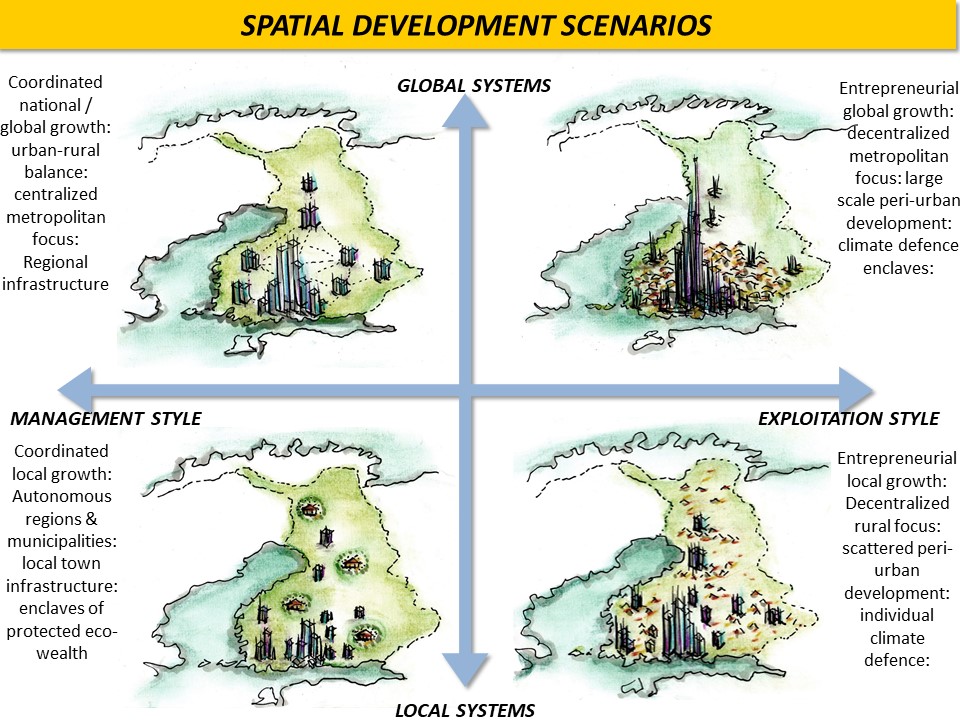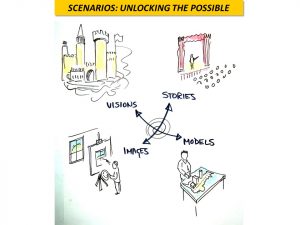Secanrios
These scenarios are created by the Bemine project, as part of the Integrated Visioning Toolkit. They were developed in a scenario workshop, by 30 participants from 14 institutions, from Finland and other countries.
The scenarios are not forecasts or projections: they are structured ’what-if’ questions or stress-tests, exploring alternative versions of an unknown future. The scenarios are organized around 2 types of uncertainties:
- Global or local-regional systems: in technology & socio-political organization
- Management style or exploitation style: in resources, climate change, and socio-economic structures
The scenarios have a time-scale of 2040-2050, just beyond the normal planning / investment horizon.
The scenarios were developed from a regional approach: the workshop sub-groups explored the issues, from the Helsinki metropolitan region, other major cities, rural towns, and remote regions.
Scenario applications are both technical and social. The technical roles include land use and transport modelling, economic models, demographic projections.
There are four main scenarios. Each has ’surprises and shocks’: and each has a ’counter-vailing’ force.
There are spatial development and urban-regional implications. This graphic shows the main issues in spatial development:
- Global management: coordinated, balanced, metropolitan focus.
- Global exploitation: entrepreneurial, adhoc, metropolitan and peri-urban focus.
- Local management: autonomous municipalities, enclaves of protected eco-wealth.
- Local exploitation: entrepreneurial, ad-hoc, decentralized rural focus.

Summary of the scenario storylines:
A. Global management (“Cyber-landia”)
The digital revolution goes further and faster: major platforms combine with governments, from local to global. Society is more equal and transparent, & can manage climate change and resource use. The downside is’government by algorithm’, and the young live more in the virtual world than the real. Many move to the central metropolitan region, as much for social life as for material reasons. For the cities, there is optimum of urban design, in high-density mixed-use communities. Rural & remote regions grow by planned migration. But paranoia is growing, that society is run by and for machines.
B. Global exploitation (“Petro-polis”)
Finland grows in a free market global economy with both digital and bio-economy skills. But social inequality also grows, with the corporate buy-out of government and public services. The unskilled are excluded, and some move to industrial areas or remote forests. Most workers are ’owned’ by corporate work-life Platforms, and co-locate like nomads, across the ’peri-metro-region’ of southern Finland. Climate change accelerates and the wealthy now live in protected ’climate-spheres’. Climate also brings opportunities in markets, auctions, eco-technologies, and property values.
C. Local management (“Conserva-landia”)
Finland goes local, in a reaction to globalization: but the result is a more rigid social hierarchy, based on land and resources. Those with assets become richer, while others get low value jobs. In nature conservation areas, local landowners sell prime locations to global billionaires. Rural towns and cities are glad to see growth, but with less mobile populations, community / labour organizations are easily controlled. Many urban neighbourhoods are almost static, with an invisible ’insider’ system for access to housing and public services. Coordination across cities and regions is more difficult, with policy-makers staying inside their boxes.
D. Local exploitation (“Extract-polis”)
Many local communities grow with a free market exploitation of resources: local entrepreneurs harvest the forests and bio-economy materials, sharing the work around their villages and towns. In autonomous urban neighbourhoods and suburban communities, there are new enterprises, where the profits are reinvested locally. The metropolitan region lacks coordination, so each municipality aims towards self-reliance. Meanwhile there is extreme climate change, with storms, floods, heatwaves, sea-level rise, pests and diseases. Many people live a nomadic existence between urban / rural, and summer / winter.
Context
The Bemine scenarios set and the scenario planning method, is an essential part of the ‘Integrative Visioning Toolkit’ (‘IVT’), as in the Bemine proposal (see the Annex 2.).

Generally, scenario methods are an essential part of any forward / strategic planning or research.
- scenario methods help to stress-test & future-proof policies & plans:
- explore creative ideas and opportunities:
- look for possibilities which are out-of-the-box, transformative, disruptive, etc.
- So, creative thinking is essential, as in the graphic:
This scenario planning method is based on stages 1&2 of the Integrated Vision Toolkit (i.e. baseline & scenario mapping), as outlined in Annex B. The ‘co-creation’ / co-design method and toolkit is similar to stages 3&4, (synergy & pathway mapping / design), as in Annex B. This will be the focus of the next workshop. This will first explore the desired or ‘normative’ scenarios, i.e. visions / synergies / back-casting / ‘success’ scenarios. Then it will explore pathways / road-maps / strategies to achieve the visions.
Drivers of change and uncertainity
Research teams were requested to look at the Matrix of Uncertainty & Change below, and provide feedback on the following questions:
- Can you identify which of the possible factors of ‘uncertainty / change’ are most relevant to your work?
- Can you add new factors of uncertainty / change ?
- if possible, send a summary of your current studies, modelling, slides etc, which are relevant to the discussion on uncertainty / change.
The combined results was used as input to the first stage of the workshop method. The matrix below identifies the main uncertainties / driving forces of change. These are the basic components of a scenario method. The most typical uncertainties for urban development are shown as questions (‘???’). The matrix has three main columns, (based on the Synergistic Toolkit):
- Mode-I column: – direct & ‘quantitative’ uncertainties: these are more relevant for MALPE calculations.
- Mode-II column: – ‘evolutionary’ uncertainties, more relevant for enterprises who work with MALPE.
- Mode-III column: the ‘co-evolutionary’ uncertainties, more qualitative, with complexities, controversies, disruptions or transformations.
‘Wider’: (sectors)
| Mode-I Linear | Mode-II Evolutionary | Mode-III Co-evolutionary | |
| Housing & neighbourhood | Housing as units | Housing as markets | Housing as communities |
| household size: larger /smaller? Household size vs. unit size: where and with which standards | housing market growth: faster / slower? Increasing division between buoyant and declining housing markets | Cohousing development, partnerships between housing companies, developers and municipalities in urban densification, differentiation in housing policy & development. | |
| Urban services, public / private | Shopping, health, education services | Shopping, health, education markets | Shopping, health, education lifestyles |
| Local VS online services: more / less?? Centralization/de-centralization of services | Privatization of services: more / less?? Client-turned-producer, digital platform companies for user transactions (Uber, Airbnb, housing markets, used goods etc.) | Transformation in service co-production?? Client-turned-producer, sharing culture, self-organized communities, direct user-user service transactions | |
| Transport / spatial infrastructure | Transport as trips | Transport as networks | Transport as accessibility/aspect of usability |
| Car VS public transport: more / less? New ‘light traffic’ modes (e-bikes etc.) | Private vs public ownership (roads, lines etc): more / less? Marketization of transit services and provision of transport infrastructure | Client-turned-producer, new private transit services, sharing culture, MaaS, from system to user-orientation. Transit as a driver for urban development | |
| enterprise development | Office / factory units | Office / factory markets | Office / factory systems |
| Centralized / decentralized home workspace? | Multi-locational working & lifestyle: more / less? What is work and how will it interlace with recreation | Transformation in meaning of work etc? Robotization and increased freetime: lifestyle coaches, voluntary community work, arts & crafts… | |
| Spatial development | Linear urban expansion | adaptive growth & rural-urban links | Spatial system transformation |
| Urban centralization/ decentralization? Regional-national cent/dec? Monocent vs. polycentric urban structures; mixed vs. monofunctional zoning | Changing urban-rural relations: faster / slower? “new ruralism vs new urbanism; polarizing patterns and specialisation of the periurban & rural | Spatial differentiation (in relation to community, culture, accessibility, lifestyle etc.) Changing priorities of/in spatial organization: economy/something else | |
| Urban policy | Direct regulation, e.g. green belt | Market-based incentives e.g. ecosystem services | Governance participation & co-creation |
| Command & control regulation: more / less?? More accentuated roles for hard regulation and soft policy; no-go zones vs. development zones | Market based governance: more / less?? Privatisation of natural monopolies; state contractual policies, economic devolution, leverage planning | New forms of citizen governance: more / less?? Fragmented, tribal civil society; activity-based initiatives Hybrid Urban Development? |
Deeper: (domains)
| Mode-I Linear | Mode-II Evolutionary | Mode-III Co-evolutionary | |
| Social | Population growth | Social networks | Social intelligence |
| National pop. growth: higher / lower?? Ageing, immigration |
Pop. structure change: faster / slower?? Socio-economic segregation, cultural differentiation |
Social & cultural cohesion: More / less?? New socio-economic communities, both local and ubiquitous |
|
| Technical | Mono-functional | Multi-functional | Integrated systems |
| Technology innovation: faster / slower? |
Technology innovation: More / less disruptive? Transformation of mundane technologies with broad impacts on everyday urban lives and organization of society (smart cities, smart homes, SDCs etc.) |
Technology transformation?? Client-turned-producer (3D printing, programming etc.), crowdsourcing, technology nostalgia (slow living, out of the grid) |
|
| Economic | Industrial production | capital & markets | Holistic livelihoods |
| Economic GDP: more / less?? Heightened global competition, major cities as networked growth machines vs. “slow cities” |
Investment: faster/slower? Hypercapitalism vs. slow economies in the periphery Investment: where (firms, infrastructures, “competitiveness”; cities, regions, corridors?) and how (which government technologies?) |
Economic transformation?? Green busine |
|
| Environment | Green-space area | Green-space functions | Green-space in society |
| Climate change: faster / slower? Climate regulation: more/less |
Climate adaptation: more / less? Short term adaptation (sea level rise, storms etc.) vs. long term mitigation (GHG emissions, non-renewable energy sources etc.) |
Climate co-evolution?? New low-carbon lifestyles, distributed renewable energy production |
|
| Political | Institutional structures | Power games & processes | Political intelligence |
| Government share of GDP: More / less? Les welfare state (equity), more citizen responsibility (activity) |
Policy innovation: Faster / slower? New Public (networked) Governance vs. ambiguities in legitimacy, accountability and sovereignty |
Governance transformation?? Digital Era Governance, more community level autonomy/self-organization |
|
| Other | Region = bunch of neighbouring municipalities | Emerging urban region | Building regional understanding |
| Division of labour in administration | Identifying the proxies | Break the silos/, away with the sub-optimisation |
